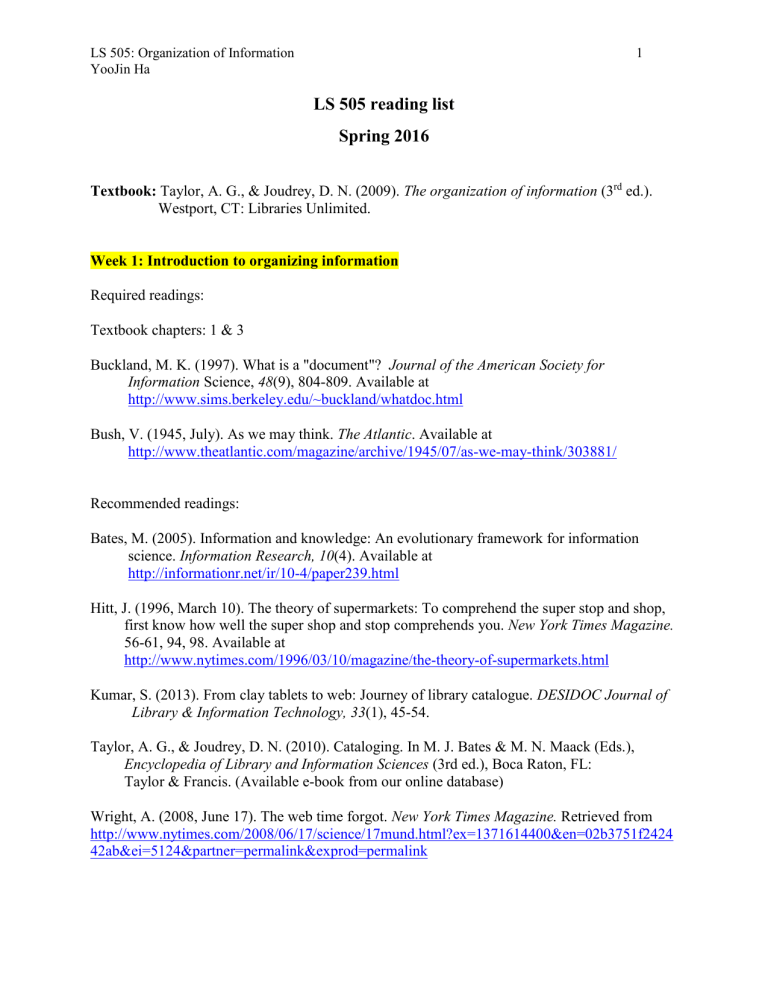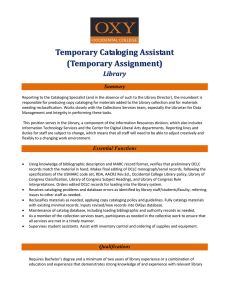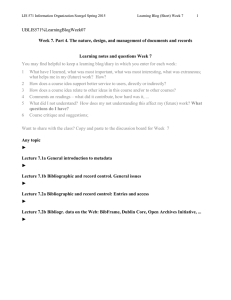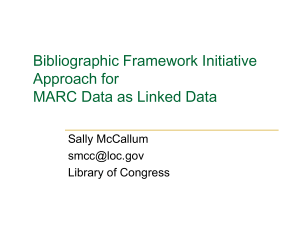
LS 505: Organization of Information YooJin Ha 1 LS 505 reading list Spring 2016 Textbook: Taylor, A. G., & Joudrey, D. N. (2009). The organization of information (3rd ed.). Westport, CT: Libraries Unlimited. Week 1: Introduction to organizing information Required readings: Textbook chapters: 1 & 3 Buckland, M. K. (1997). What is a "document"? Journal of the American Society for Information Science, 48(9), 804-809. Available at http://www.sims.berkeley.edu/~buckland/whatdoc.html Bush, V. (1945, July). As we may think. The Atlantic. Available at http://www.theatlantic.com/magazine/archive/1945/07/as-we-may-think/303881/ Recommended readings: Bates, M. (2005). Information and knowledge: An evolutionary framework for information science. Information Research, 10(4). Available at http://informationr.net/ir/10-4/paper239.html Hitt, J. (1996, March 10). The theory of supermarkets: To comprehend the super stop and shop, first know how well the super shop and stop comprehends you. New York Times Magazine. 56-61, 94, 98. Available at http://www.nytimes.com/1996/03/10/magazine/the-theory-of-supermarkets.html Kumar, S. (2013). From clay tablets to web: Journey of library catalogue. DESIDOC Journal of Library & Information Technology, 33(1), 45-54. Taylor, A. G., & Joudrey, D. N. (2010). Cataloging. In M. J. Bates & M. N. Maack (Eds.), Encyclopedia of Library and Information Sciences (3rd ed.), Boca Raton, FL: Taylor & Francis. (Available e-book from our online database) Wright, A. (2008, June 17). The web time forgot. New York Times Magazine. Retrieved from http://www.nytimes.com/2008/06/17/science/17mund.html?ex=1371614400&en=02b3751f2424 42ab&ei=5124&partner=permalink&exprod=permalink LS 505: Organization of Information YooJin Ha 2 Week 2: Users and information seeking Recommended readings: Bates, M. J. (2010). Information behavior. In M. J. Bates & M. N. Maack (Eds.), Encyclopedia of Library and Information Sciences (3rd ed.). (pp. 2381-2391). New York, NY: CRC Press. -- available at http://pages.gseis.ucla.edu/faculty/bates/articles/information-behavior.html Wilson, T.D. (2000). Human information behavior. Informing Science, 3(2), 49-56. -- available at http://www.inform.nu/Articles/Vol3/v3n2p49-56.pdf Week 3: Information Storage and Retrieval Required readings: Textbook chapters: 2 & 6 Borgman, C.L. (1996). Why are online catalogs still hard to use? Journal of the American Society for Information Science, 47(7), 493-503. Recommended readings: Bidney, M., & Clair, K. (2014). Harnessing the geospatial semantic web: Toward place-based information organization and access. Cataloging & Classification Quarterly, 52(1), 69-76. Calhoun, K., Cantrell, J., Gallagher, P., & Hawk, J. (2009). Online catalogs: What users and librarians want. An OCLC Report. Dublin, Ohio: OCLC. Available at http://www.oclc.org/reports/onlinecatalogs/fullreport.pdf Yee, M. M. (2009). Wholly visionary: The American Library Association, the Library of Congress, and the Card Distribution Program. Library Resources & Technical Services, 53(2), 68-78. Week 4: Introduction to Metadata Required readings: Textbook chapter: 4 Coyle, K. (2010). Library data in a modern context. Library Technology Report, 46(1), 5-13. NISO (2004). Understanding Metadata. (pp. 1-12). Retrieved from http://www.niso.org/standards/resources/UnderstandingMetadata.pdf LS 505: Organization of Information YooJin Ha 3 Recommended readings: Coyle, K. (2012). Metadata elements. Library Technology Reports, 48(4), 15-26. Recommend to read other chapters on the reports: Preface, introduction, semantic web and linked data. Duval, E., Hodges, W., Sutton, S. A., & Weibel, S. L. (2002). Metadata principles and practicalities. D-Lib Magazine, 8(4). Available at http://www.dlib.org/dlib/april02/weibel/04weibel.html Gorzalski, M. (2013). Examining user-created description in the archival profession. Journal Of Archival Organization, 11(1/2), 1-22. Kennedy, M. (2008). Nine questions to guide you in choosing a metadata schema. Journal of Digital Information, 9(26). Retrieved from http://journals.tdl.org/jodi/article/view/226/205 Weeks 5-6: Encoding standards Required readings: Textbook chapter: 5 Library of Congress. (2004). Understanding MARC bibliographic: Machine readable cataloging. (Part I-VI).Washington, D.C.: Library of Congress Library of Congress. Available at http://www.loc.gov/marc/uma/ Library of Congress. (2012). Bibliographic framework as a web of data: Linked data model and supporting services. Available at http://www.loc.gov/bibframe/pdf/marcld-report-11-21-2012.pdf W3C. (2011). XML in 10 points. Retrieved from http://www.w3.org/XML/1999/XML-in-10points Recommended readings: Relevant articles from The Encyclopedia of Library and Information Science, 3rd ed. In M. J. Bates & M. N. Maack (Eds.), Encyclopedia of Library and Information Sciences (3rd ed.), Boca Raton, FL: Taylor & Francis. (available e-book from our online database) Clarke, "Extensible Markup Language (XML)" LS 505: Organization of Information YooJin Ha 4 Gibbins and Shadbolt, "Resource Description Framework (RDF)" Pitti, "Encoded Archival Description (EAD)" Salminen, "Markup Languages" Wusteman, "Document Type Definition (DTD)" Articles: Byrne, G., & Goddard, L. (2010). The strongest link: Libraries and linked data. D-Lib Magazine, 16(11). Available at http://www.dlib.org/dlib/november10/byrne/11byrne.html Debus-López, K. E., Barber, D., Saccucci, C., & Williams, C. (2013). The electronic cataloging in publication cataloging partnership program: A model for cooperative cataloging for the twenty-first Century. Cataloging & Classification Quarterly, 51(1-3), 25-54. Huwe, T. (2010). The new ascendancy of metadata and taxonomy skills. Computers in Libraries, 30(9), 29-31. Kroeger, A. (2013). The road to BIBFRAME: The evolution of the Idea of bibliographic transition into a post-MARC Future. Cataloging & Classification Quarterly, 51(8), 873890. MacNeil, H. (2009). Trusting description: Authenticity, accountability, and archival Description standards. Journal of Archival Organization, 7, 89-107. Park, J., & Tosaka, Y. (2010). Metadata creation practices in digital repositories and collections: Schemata, selection criteria, and interoperability. Information Technology and Libraries, 29(3), 104-116. Website Resources: MARC Library of Congress, Network Development and MARC Standards Office (2008). MARC Standards. Washington, D.C.: Library of Congress. Available at http://lcweb.loc.gov/marc/ MARC 21 Format for Bibliographic Data. http://www.loc.gov/marc/bibliographic/ MARC 21 Format for Bibliographic Data Field List. http://www.loc.gov/marc/bibliographic/ecbdlist.html MARC in XML. http://www.loc.gov/marc/marcxml.html LS 505: Organization of Information YooJin Ha 5 Others ASCII Table and Description. http://www.asciitable.com Dublin Core Metadata Initiative. DCMI Metadata Terms. http://dublincore.org/documents/dcmiterms/ Dublincoregenerator.com - a better Dublin Core generator http://www.dublincoregenerator.com/generator_nq.html Encoded Archival Description (EAD). http://www.loc.gov/ead/ Encoded Archival Context (EAC-CPF) http://eac.staatsbibliothek-berlin.de/ Metadata Object Description Schema (MODS). http://www.loc.gov/standards/mods/ ONIX (Publisher Metadata) http://www.editeur.org/8/ONIX/ OCLC. Bibliographic Formats and Standards. http://www.oclc.org/bibformats/en/ Text Encoding Initiative. http://www.tei-c.org/ W3C Semantic Web Frequently Asked Questions. http://www.w3.org/RDF/FAQ W3C Metadata Activity Statement http://www.w3.org/Metadata/Activity.html Virtual International Authority File (VIAF): http://www.oclc.org/research/activities/viaf.html Visual Resources Association (VRA Core). http://core.vraweb.org/ VRA Core elements http://www.loc.gov/standards/vracore/VRA_Core4_Element_Description.pdf Week 7: Metadata Description Required readings: Textbook chapter: 7 Spiteri, L. (2011). Using social discovery systems to leverage user-generated metadata. Bulletin of the American Society for Information Science and Technology, 37(4), 27-29. Tillett, B. (2004). What is FRBR?: A conceptual model for the bibliographic universe. Retrieved from http://www.loc.gov/cds/downloads/FRBR.PDF LS 505: Organization of Information YooJin Ha 6 Dublin Core Metadata Initiative. http://dublincore.org/ - Review Dublin Core DCMI specifications page (http://www.dublincore.org/specifications/). Examine closely the DCMI Metadata Terms under ‘Semantic recommendations’ including the Dublin Core Metadata Element Set. You may also wish to look at the section called Using Dublin Core because it's very readable, but you should know that Guidelines for Dublin Core Application Profiles is more current. Resource Description and Access (RDA) http://www.loc.gov/aba/rda/ RDA and OCLC. https://www.oclc.org/rda.en.html IFLA. Functional Requirements for Bibliographic Records. (FRBR). http://www.ifla.org/files/cataloguing/frbr/frbr_2008.pdf Recommended readings: Coyle, K., & Hillman, D. (2007). Resource Description and Access (RDA): Cataloging rules for the 20th century. D-Lib Magazine, 13(1/2). Available at http://www.dlib.org/dlib/january07/coyle/01coyle.html Miksa, S. D. (2009). Resource Description and Access and new research potentials. Bulletin of the American Society for Information Science and Technology 35(5). Available at http://www.asis.org/Bulletin/Jun-09/JunJul09_Miksa.html Miller, L. (2011). Resource Description and Access (RDA): An introduction for reference librarians. Reference & User Services Quarterly, 50(3), 216-222. Srinivasan, R., Boast, R., Furner, J., & Becvar, K.M. (2009). Digital museums and diverse cultural knowledge: Moving past the traditional catalog. Information Society, 25(4), 265278. Week 8: Access and Authority Control Required readings: Textbook chapter: 8 Tillett, B. B. (2004). Authority control state of the art and new perspectives. Cataloging & Classification Quarterly, 38(3/4), 23-42. UW iSchool IMLS Project. Learning Linked Data. http://lld.ischool.uw.edu/wp/learning/understanding-linked-data/ - Read as much as you can on the "learning topics" pages. LS 505: Organization of Information YooJin Ha 7 Recommended readings: Borbinha, J. Authority control in the world of metadata. Cataloging & Classification Quarterly 38(3/4), 105-116. Gorman, M. (2004). Authority control in the context of bibliographic control in the electronic environment. Cataloging & Classification Quarterly, 38(3), 11-22. Hennessey, C. L. (2014). Authority control of relationship designators in RDA, and authority control in data repositories and digital projects. A report of the LITA/ALCTS Authority control Interest Group Program, American Library Association Annual Conference, Chicago, June 2013. Technical Services Quarterly, 31(2), 173. Jeng, L. H. (2002). What authority? why control? Cataloging & Classification Quarterly, 34(4), 91-97. Park, J.-R. (2009). Metadata quality in digital repositories: A survey of the current state of the art. Cataloging & Classification Quarterly, 47(3/4), 213-228. Salo, D. (2009). Name authority control in institutional repositories. Cataloging & Classification Quarterly, 47(3/4): 249-261. Web Resources: Introducing Linked Data and the Semantic Web / LinkedDataTools.com (available at: http://www.linkeddatatools.com/semantic-web-basics) Read/review: The Basics: Introducing Graph Data; Introducing RDF; Semantic Modeling. Crosswalk examples: MARC to Dublin Core: http://www.loc.gov/marc/marc2dc.html Dublin Core to MARC: http://www.loc.gov/marc/dccross.html ONIX to MARC 21: http://lcweb.loc.gov/marc/onix2marc.html Week 9: Subject Analysis Required Readings: Textbook chapters: 9 & Appendix A LS 505: Organization of Information YooJin Ha 8 Recommended Readings Aitchison, J., & Clarke, S. D. (2004). The thesaurus: A historical viewpoint with a look to the future. Cataloging & Classification Quarterly, 37(3/4), 5-21. Mai, J. (2000). Deconstructing the indexing process. Advances in Librarianship, 23, 269-298. Available at http://jenserikmai.info/Papers/2000_Deconstructing.pdf Svenonius, E. (2000). LCSH: Semantics, syntax and specificity. Cataloging & Classification Quarterly, 29(1/2), 17-30. Wilson, P. (1968). Subjects and the sense of position. (pp. 69-92). Two kinds of power: An essay on bibliographical control. Berkeley, CA: University of California Press. Available at http://books.google.com/books?id=DePy_aazKI4C&lpg=PP1&pg=PA69#v=onepage&q&f=fals e Weeks 10-11: Vocabulary Control Required Readings: Textbook chapter: 10 Coyle, K. (2012). Vocabularies: Term lists and thesauri. Library Technology Reports, 48(4), 2735. Mai, J-E. (2011). The modernity of classification. Journal of Documentation, 67(4), 710-730. Recommended Readings: Beall, J. (2010). The shortcomings of full-text searching" (10-minute online presentation). Retrieved from http://www.catalogingfutures.com/catalogingfutures/2010/04/theshortcomings-of-fulltext-searching.htm Jacob, E. (2004). Classification and categorization: A difference that makes a difference. Library Trends 52(3), 515-540. Available at https://www.ideals.illinois.edu/bitstream/handle/2142/1686/Jacob515540.pdf Jacob, E. K. (2003). Ontologies and the semantic web. Bulletin of the American Society for Information Science and Technology 29(4), 19-22. Available at http://www.asis.org/Bulletin/Apr-03/BulletinAprMay03.pdf King, R., & Reinold, K. (2008). Organizing Knowledge. In finding the concept, not just the word: A librarian's guide to ontologies and semantics. (pp. 3-14). Oxford: Chandos. Lee, D., & Stvilia, B. (2014). Developing a data identifier taxonomy. Cataloging & Classification Quarterly, 52(3), 303-336. LS 505: Organization of Information YooJin Ha 9 Mann, T. (2005). Will Google’s keyword searching eliminate the need for LC cataloging and classification?. Retrieved from http://www.guild2910.org/searching.htm Ranganathan, S.R. (1962). The laws of library science and chapters A-E. In elements of library classification (3rd. ed.). (pp. 8-41). Bombay: Asia Publishing House. Shearer, J. R. (2004). A practical exercise in building a thesaurus. Cataloging & Classification Quarterly, 37(3), 35-56. Smith, G. (2008). Tagging: Emerging trends. Bulletin of the American Society for Information Science and Technology. 34(6). Available at http://www.asis.org/Bulletin/Aug-08/AugSep08_Smith.html White, H. (2013). Examining scientific vocabulary: Mapping controlled vocabularies with free text keywords. Cataloging & Classification Quarterly, 51(6), 655-674. Web resources: Getty Vocabularies http://www.getty.edu/research/tools/vocabularies/index.html WordNet. http://wordnet.princeton.edu/ U.S. National Library of Medicine. Fact sheet: Medical Subject Headings (MESH)"http://www.nlm.nih.gov/pubs/factsheets/mesh.html Thesaurus principles and practices. http://www.willpowerinfo.co.uk/thesprin.htm Thesaurus construction. http://publish.uwo.ca/~craven/677/thesaur/main00.htm Relevant Articles from The Encyclopedia of Library and Information Science, 3rd ed. In M. J. Bates & M. N. Maack (Eds.), Encyclopedia of Library and Information Sciences (3rd ed.), Boca Raton, FL: Taylor & Francis. (available e-book from our online database) Anderson and Pérez-Carballo, "Library of Congress Subject Headings (LCSH)" Baca, "Controlled Vocabularies for Art, Architecture, and Material Culture" Bruijn and Fensel, "Ontologies and Their Definition" Furner, "Folksonomies" Hodges and Chan, "Subject Cataloging Principles and Systems" Poo and Khoo, "Online Catalog Subject Searching" LS 505: Organization of Information YooJin Ha 10 Weeks 12-13: Categorization, Classification, & Arrangement Required Readings: Textbook chapter: 11 Appendices B & C Kwasnik, B. (1999). The role of classification in knowledge representation and discovery. Library Trends, 48(1), 22-47. Recommended readings: Mai, J-E. (2013). Ethics, values and morality in contemporary library classifications. Knowledge Organization, 40(4), 242-253. Available at http://jenserikmai.info/Papers/2013_Ethics.pdf Ranganathan, S.R. (1967). Part H. Notational plane, Chapters HA-HC. (pp. 217-242). In Prolegomena to Library Classification (3rd ed.). Relevant Articles from The Encyclopedia of Library and Information Science, 3rd ed. In M. J. Bates & M. N. Maack (Eds.), Encyclopedia of Library and Information Sciences (3rd ed.), Boca Raton, FL: Taylor & Francis. (available e-book from our online database) Beghtol, "Classification Theory" Foskett, "Facet Analysis [ELIS Classic]" Grove, "Taxonomy" McIlwaine, "Universal Decimal Classification (UDC)" Mitchell and Vizine-Goetz, "Dewey Decimal Classification (DDC)" Olson, "Social Influences on Classification" Satija and Singh, "Colon Classification"



